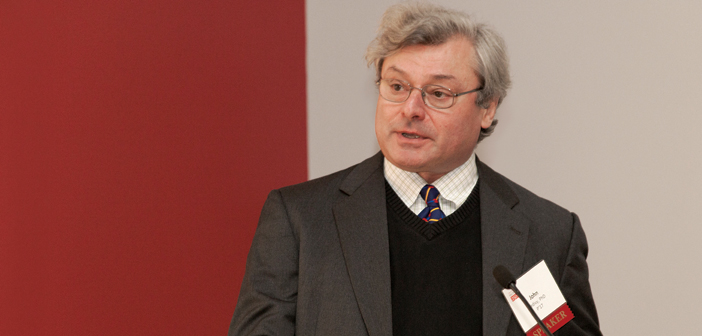Aging is unavoidable, but science might help us do it better.
A century ago, the average life expectancy in the United States was around 54 years. Now, thanks to improvements in sanitation, antibiotics, and vaccines, the average American lives almost to 80. But not only can we not live forever, we can’t live much longer than that.
John Sedivy, PhD P’19, the Hermon C. Bumpus Professor of Biology, says that’s because our longevity is genetically determined, and we’re now rubbing up against the upper limit. “A dog lives 12 years and a cat lives 18 years and a horse lives 30 years and a chimpanzee lives 45 years, even in the absolutely best environment,” he says. “There’s a barrier; a dog is never going to live as long as a horse. Never.”
As people live longer and spend more time in old age, they spend more time suffering from the diseases associated with aging, from arthritis to dementia. Researchers at Brown are trying to understand the molecular mechanisms that control not just how old a person gets, but how he or she ages—with the ultimate goal of lengthening the human “healthspan,” the years we spend without age-related health problems.
“There is a lot of new research in the last 10 to 15 years that very clearly says that aging is actually something that we can do something about,” Sedivy says. He started his career as a cancer biologist, but serendipity, he says, led him to aging research in the late 1990s, when his group at Brown was studying a gene that, when overexpressed, causes cancer. “We found that if you go in the opposite direction”—if you reduce the activity of the gene—“you actually extend lifespan by a really nice chunk, like 15 to 20 percent in the mouse,” he says.
Around that same time, Marc Tatar, PhD, arrived at Brown from the University of Minnesota, where he’d been studying longevity in fruit flies. Upon discovering their shared interest, he and Sedivy started the Brown Biology of Aging Initiative; nearly two decades later, the program has grown to include 19 faculty from several Brown departments and affiliated hospitals. The group coordinates a seminar series featuring outside speakers; the Providence Area Aging Research Forum (or PAARF, so named after Sedivy’s idea—the Brown Aging Research Forum—was self-vetoed); and the annual Colloquium on the Biology of Human Aging, a daylong affair featuring talks by the glitterati of the aging field, which has taken place every May since 1998.
They also are trying to raise undergraduate interest. Sedivy, Tatar, and Professor of Biology Stephen Helfand, MD P’19, coteach an upper-level seminar, “The Biology of Aging,” which examines demographics as well as molecular, cellular, and genetic processes. “It’s a unique experience for the students in that you have three established senior scientists who’ve done very well, experts in the field, in the same room, and we will often disagree,” Helfand says. “We have slightly different opinions about how things work, and the students get to see a balanced, sometimes lively, but very tactful discussion on these things.” The course goes beyond the nitty gritty of the biology of aging—students also learn about the process of science funding by writing a mock grant and participating in a mock peer review of grant applications, like an NIH study section.
Tatar, now a professor of biology, hopes that someday every researcher in the initiative will share the same physical space. “My vision is that we could be like cold fusion if we just had a magnetic field to hold us together,” he says. But for now, says Louis Lapierre, PhD, assistant professor of molecular biology, cell biology, and biochemistry, the initiative, despite the faculty’s disparate locations, is working. “It’s a positive environment to do research in,” he says.
And it welcomes people of disparate skills. Nicola Neretti PhD’01 came to Brown to study physics, but he made the jump to biology, and specifically aging, when Tatar and Sedivy co-mentored him on a grant. “Aging, to me, is such an interesting problem because, first of all, everybody ages, so it’s relevant for everyone; and second, it’s the highest risk factor for most diseases,” says Neretti, an assistant professor of biology. “If we can delay the onset of aging, [we]can delay the onset of these chronic diseases.”
For Tatar, whose father has Alzheimer’s disease, the group’s work has a new sense of urgency. “We really, really, really need treatments that can ameliorate the pain and suffering that people have as they are aging and becoming disabled,” he says.
As the worm turns
Louis Lapierre likens the effect of aging on cells to a tedious, timeless chore. “It’s like laundry. You always have to do it or else it’s going to pile up,” he says. Cells rejuvenate themselves through autophagy, or self-eating, in which lysosomes break down damaged parts. B ut this pathway becomes less efficient as organisms get older, and damaged material starts to accumulate. “It’s a fight against time,” he says.
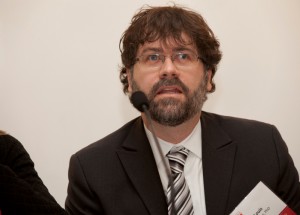
Louis Lapierre
Using the nematode Caenorhabditis elegans—a good model to study aging due to its small size, short lifespan, and well-characterized biology—Lapierre is seeking ways to maintain the efficiency of autophagy to forestall the deleterious side effects of getting older. His year-old lab already has published its first research report, in the journal Autophagy, showing that sustaining the process in C. elegans does, indeed, delay aging; other researchers have made similar findings in flies and mice. “We know if we genetically improve autophagy by increasing the expression of certain autophagy-related genes, we can extend lifespan,” he says.
Lapierre hopes to identify genes that modulate the autophagy pathway and determine whether they could be used to develop new drugs to target age-related diseases. “C. elegans will allow us to look at the machineries inside the cells,” he says. But, he cautions, “we and others will have to think about their implications in human physiology.”
Fly guys
Marc Tatar, an evolutionary biologist, studies how hormones control aging in Drosophila. His lab discovered that mutations that change insulin signaling pathways cause the flies to live longer, healthier lives. “The flies are amazing,” Tatar says. “When we have these old [mutant]flies and we compare them to controls, the controls are dragging their little wings and selves along the bottom of the cage and the mutants are flying around like popcorn.”
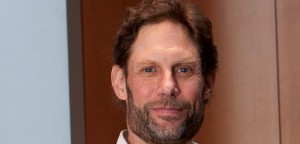
Marc Tatar
His lab is trying to determine just how insulin signaling controls aging in Drosophila. This is tricky because flies
contain eight different insulin peptides that all signal to the same receptor. In turn, this receptor regulates everything from fly growth and metabolism to reproduction, development, and aging. To explore how these different insulins can have different effects when they bind to the same receptor, Tatar and colleagues have begun looking at mutations in two insulin genes. “We’re trying to figure out: How does one receptor respond differently to different insulins? What kinds of different outputs do they generate?” Tatar says. “And which ones are associated with aging?”
The lab also is studying the structure and biochemistry of the insulin receptor by using a technique called homologous recombination to change particular amino acids within the receptor protein. “That’s a big project. It’s very technically hard to do,” he says. “We’ve been doing homologous recombination for three years, and we finally have a small series of alleles to start studying.”
Taken together, Tatar’s research could lay the groundwork for determining whether there are hormonal manipulations within this system that may apply to human aging. Hormones, like insulin, are an attractive potential target in part because they are usually well tolerated and can be taken orally or via injection.
Stephen Helfand, a board-certified neurologist who started off studying development, had no prior background in Drosophila genetics and aging and is largely self-taught—or, as he likes to joke, “I’ve been learning this on the fly.”
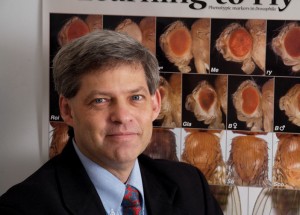
Stephen Helfand
He did get some help from one of his heroes: Seymour Benzer, PhD, a pioneer in neurogenetics. Benzer had identified a Drosophila gene, called “drop dead,” that causes premature death. Helfand, meanwhile, had discovered genes whose expression levels changed as flies aged, suggesting that they could be used as biomarkers for aging. So he and Benzer teamed up to see whether the drop-dead flies were dropping dead because they were aging too quickly.
But first they had to determine how long control flies live. Drosophila with a mutation in one control gene lived 180 days, when other controls died at 120 or 130 days. “I threatened at about 170 days to come in on the weekend when nobody was around and kill them all so I could just get the paper,” Helfand laughs. “And somewhere around 180, we said, ‘Gee, I wonder why they’re living so long?’” It was then that he realized he’d stumbled upon a gene that controls longevity.
That gene was named “I’m not dead yet,” or Indy, thanks to a suggestion by Professor of Biology Robert Reenan, PhD, a co-author of the 2000 paper in Science. Now Helfand is looking at Indy’s role in metabolism to determine just how this mutation leads to longevity. He’s also collaborating with John Sedivy to study the role of transposable elements in aging using different mutant flies.
Survival of the stem cells
Neural stem cells are the building blocks of the brain, developing into neurons via a process called neurogenesis. But over time they lose that constructive function, says Ashley Webb, PhD, assistant professor of molecular biology, cell biology, and biochemistry. “The main focus of my lab is to understand why these neural stem cells age and why neurogenesis declines with age,” she says.
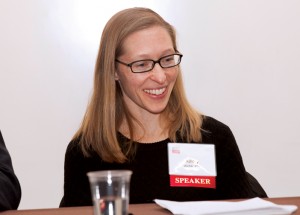
Ashley Webb
Webb, who joined Brown last year, studies the role of FOXO transcription factors, proteins that can bind to genes and turn them on, in neural stem cells. It’s a hot topic in the aging field. “It was first discovered in worms and flies—actually in work done in part by Marc Tatar—that if you increase the activity of this factor you can extend lifespan,” Webb says. The same may be true in humans. “Some studies have linked it strongly to longevity and even to extreme longevity in centenarians,” she says.
The mechanisms behind this link remain murky, but Webb is hot on the case. “We believe that FOXO is important for preserving the neural stem cells in the brain,” she says. Indeed, knocking out FOXO in a mouse speeds up the loss of neural stem cells—similar to what happens during aging.
True to the Biology of Aging Initiative’s mission, Webb has found ready collaborators at Brown. With Tatar, she is looking at the genes that FOXO targets, as well as other proteins that partner with it, to understand how neural stem cells are depleted and how that might relate to lifespan and age-related deficits like dementia. “It’s been a great opportunity for us to … put our heads together,” she says.
Gut feeling
Nicola Neretti first partnered with Marc Tatar and Stephen Helfand to study the effects of calorie restriction—an intervention that has increased longevity in model organisms—on gene expression in flies. They discovered that it changes the expression of a whole host of genes, and also appears to delay the gradual loss of gene silencing that is seen in normal aging.
Neretti also has collaborated with John Sedivy’s lab to look at epigenetic changes in senescent cells, which have stopped replicating. “As they senesce, they protect you from potentially harmful consequences of DNA damage like mutations that can give rise to cancer,” Neretti says. “But they might actually accelerate the aging process.”
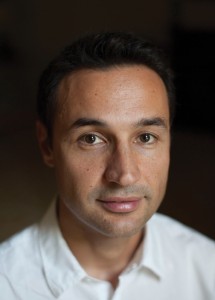
Nicola Neretti
Lately Neretti has been examining how the human microbiome might affect aging. The idea was planted when he met Luigi Ferrucci, MD, PhD, scientific director of the National Institute on Aging, who spoke at the biology of aging colloquium last year. Over time the lining of the gut becomes more permeable, allowing microorganisms to enter the blood, travel to other organs, and cause inflammation. This may lead to some of the health issues associated with aging. To explore this potential relationship, Neretti and collaborators in Brazil, Italy, and Baltimore will analyze viruses and other microbes found in the blood of people of different ages.
Sedivy, meanwhile, is looking at what he calls “life forms that infest your genome”: pieces of DNA known as transposable elements that hop from chromosome to chromosome. “We have noticed that they become more active with aging, so we’re trying to figure that out,” he says.

